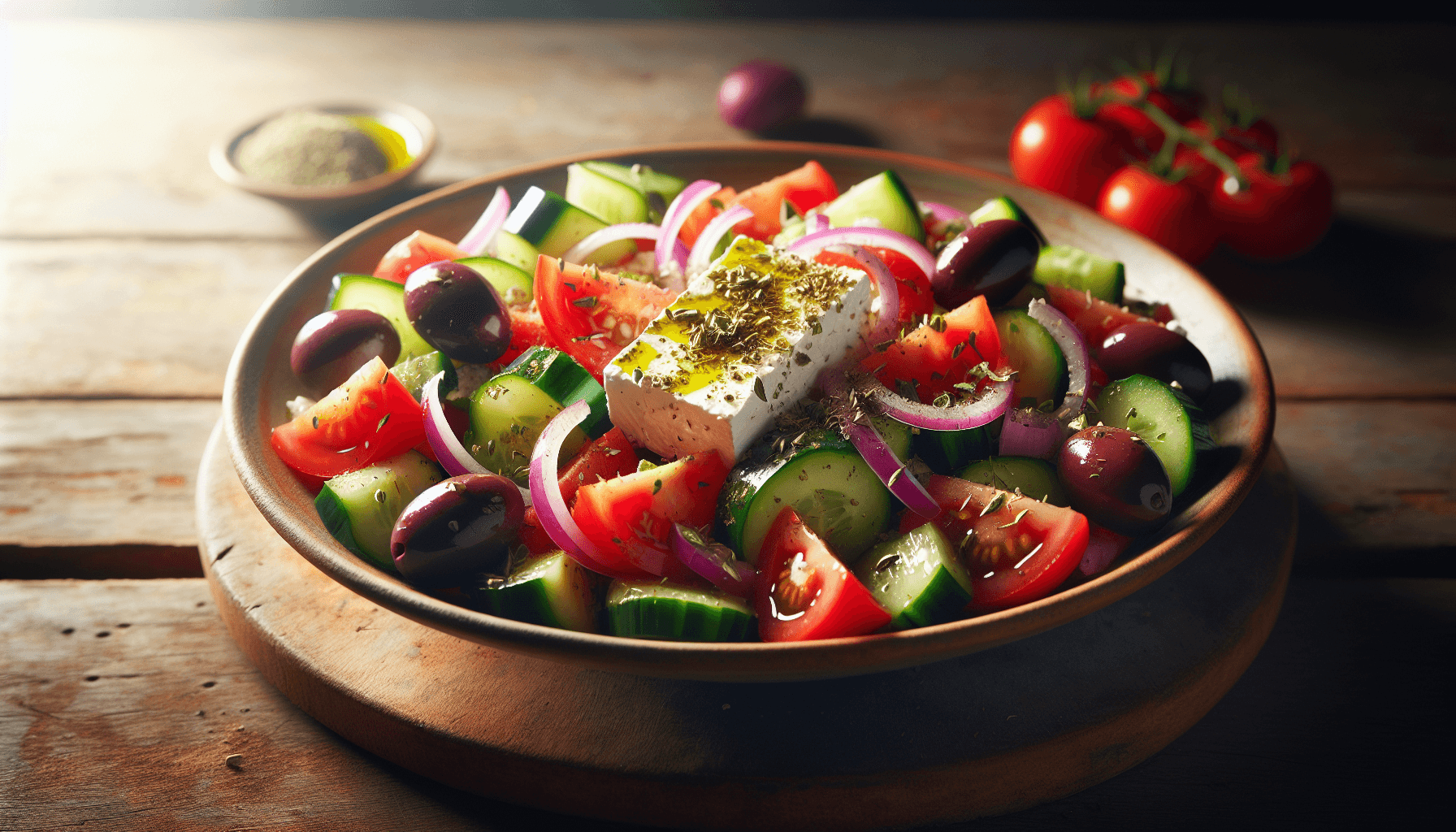Classic Horiatiki: The Quintessential Greek Salad
Greece, a land rich in history and vibrant flavors, is home to a dish that perfectly encapsulates its culinary identity: Horiatiki, or Greek salad. With a symphony of fresh vegetables, creamy feta, and briny olives, this classic dish is not just a salad—it’s a celebration of nature’s bounty. Whether you’re hosting a summer barbecue, planning a Mediterranean feast, or simply seeking a light and refreshing meal, Horiatiki is a stellar choice that combines taste and nutrition seamlessly.
Who Is This Recipe For?
This Horiatiki recipe is perfect for food lovers, health-conscious individuals, and anyone who adores Mediterranean cuisine. Its simplicity makes it ideal for novice cooks, while its vibrant flavors can satisfy even the most seasoned chefs. Making this classic Greek salad is a great way to use up fresh produce, and it only takes a few minutes to prepare. It’s perfect for warm-weather dining or with grilled meats, making it an excellent option for gatherings or quiet dinners alike.
Ingredients for Classic Horiatiki
To create this quintessential Greek salad, you will need:
- 4 ripe tomatoes, cut into wedges
- 1 cucumber, peeled and sliced into thick rounds
- 1 red onion, thinly sliced
- 1 green bell pepper, sliced
- 200g of feta cheese, preferably in a block
- 100g Kalamata olives (or any other briny olives)
- Extra virgin olive oil (to taste)
- Red wine vinegar (optional, to taste)
- Dried oregano (to taste)
- Salt and pepper (to taste)
Kitchen Equipment Needed
- Cutting board
- Sharp knife
- Mixing bowl
- Serving plate or bowl
- Measuring spoons (optional)
Directions to Prepare Classic Horiatiki
Prep the Vegetables: Begin by washing your vegetables thoroughly. Cut the tomatoes into wedge-shaped pieces, slice the cucumber into thick rounds, and thinly slice the red onion and green bell pepper. The aim is to achieve enticing rustic cuts that evoke the authentic feel of a Greek taverna.
Combine Ingredients: In a large mixing bowl, gently toss together the tomatoes, cucumber, red onion, and green bell pepper until well combined.
Add Olives and Feta: Scatter the Kalamata olives over the salad. Next, crumble the feta cheese over the top—this salad is traditionally served with the feta in large blocks, but crumbling it adds a burst of creaminess in every bite.
Dress and Season: Drizzle generous amounts of extra virgin olive oil over the salad. If desired, add splashes of red wine vinegar for an extra tang, then sprinkle dried oregano, salt, and pepper over your creation. Gently toss everything together, ensuring the feta retains its texture.
- Serve: Transfer your beautiful Horiatiki to a serving dish and garnish with a few additional olives and feta if you like. Enjoy it fresh, as Mediterranean salads taste best when made shortly before serving.
Notes and Tips for the Best Horiatiki
Fresh Ingredients Are Key: This salad is all about the freshness of its ingredients. Opt for seasonal vegetables from local markets whenever possible for superior flavor and nutrition.
Feta Cheese: Choose high-quality Greek feta if you can find it. It tends to be creamier and more flavorful than mass-produced versions.
Customization: Feel free to add or substitute ingredients—sliced radishes, capers, or even diced avocado can elevate the flavor.
Herbs: While dried oregano is traditional, fresh oregano or other herbs like mint can offer a delightful twist.
- Storage: If you happen to have leftovers (which may not be likely!), store them in an airtight container in the fridge for up to 2 days. However, be aware that the salad may become a bit soggy due to the dressing and tomatoes releasing juices.
Variations on Classic Horiatiki
Protein-Packed Horiatiki
For a protein boost, incorporate grilled chicken, shrimp, or chickpeas. This makes the salad a complete meal while adding an exciting new flavor dimension.
Quinoa Horiatiki
Mix in cooked quinoa for a hearty alternative that maintains the salad’s integrity while making it more filling.
Mediterranean Grain Salad
Instead of using traditional salad greens, mix in cooked farro or bulgur wheat for a chewy texture and nutty flavor profile that complements the other ingredients beautifully.
Food and Drink Pairings
Classic Horiatiki pairs excellently with grilled meats such as lamb, chicken, or fish, which are staples in Greek cuisine. For a refreshing drink, consider:
- A crisp white wine: Like a dry Assyrtiko, which complements the briny flavors of the olives and feta.
- A light rosé: This pairs beautifully with the freshness of the vegetables.
- Refreshing beverages: A glass of cold lemonade or a fruity mocktail can enhance your outdoor dining experience.
FAQs about Classic Horiatiki
Can I make this salad ahead of time?
While Horiatiki can be prepped a few hours in advance, it’s best dressed just before serving to maintain the crunchiness of the vegetables.
Is Horiatiki gluten-free?
Yes, this classic Greek salad is naturally gluten-free, making it an excellent option for those with gluten intolerances.
What other vegetables can I include?
Feel free to include seasonal vegetables such as radishes, artichokes, or even sweet corn for a bit of sweetness.
Conclusion
Classic Horiatiki is not just a dish; it embodies the essence of Greek culinary spirit—fresh, simple, and bursting with flavor. With minimal preparation and maximum taste, this quintessential Greek salad is a must-try for any food lover. So why not whip up a batch for your next meal?
If you enjoyed this recipe and found it helpful, please share it with your friends and family! Subscribe to our blog for more delicious recipes and culinary tips straight from the Mediterranean kitchen. Let’s keep the spirit of good food alive, one dish at a time!

















